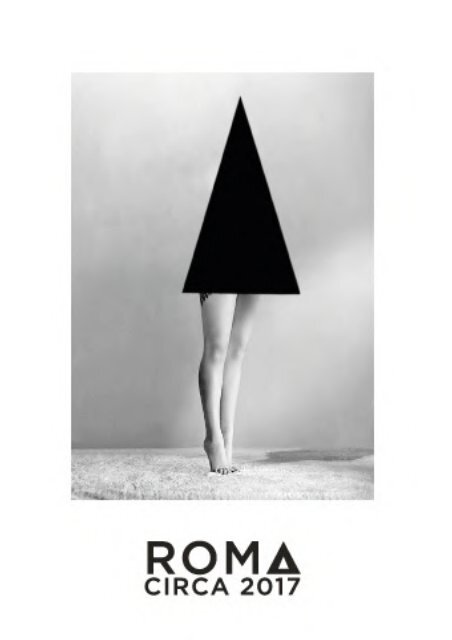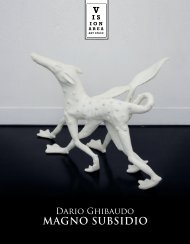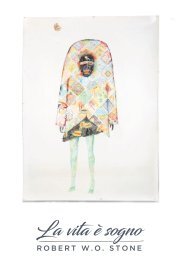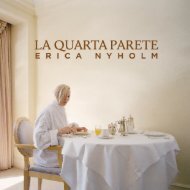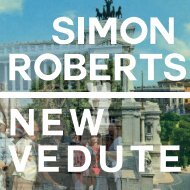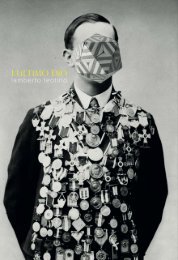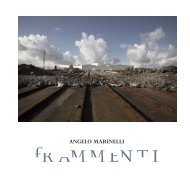You also want an ePaper? Increase the reach of your titles
YUMPU automatically turns print PDFs into web optimized ePapers that Google loves.
A cura di<br />
Curated by<br />
Claudio Composti<br />
Progetto grafico<br />
Graphic project<br />
Angelo Marinelli<br />
Comunicazione<br />
Communication<br />
ArtistProof s.r.l. <strong>Roma</strong><br />
Con il supporto di<br />
Supported by<br />
In collaborazione con<br />
In collaboration with
Quando mi sono messo a tavolino per buttare giù il titolo e qualche idea<br />
per questo libro, mi sono immaginato di passeggiare per il mercatino<br />
di Ponte Milvio nel 2050 e di trovare una vecchia scatola di cartoline<br />
con scritte le parole “<strong>Roma</strong> (circa <strong>2017</strong>)” .All’interno della scatola vi<br />
era una serie di strane e alquanto bizzarre immagini di donne, che<br />
osservavano senza essere viste. Se mi chiedeste di tracciare la storia<br />
di queste cartoline o di descrivere queste immagini, vi direi solo che<br />
queste furono recuperate da un archivio di fotografia erotica. Questa<br />
scatola di cartoline immaginaria è all’origine di questo elegante libro e<br />
sono lieto di ritrovare queste stesse parole stampate su questa pagina<br />
e firmate:Noé Sendas (<strong>Roma</strong> circa <strong>2017</strong>).<br />
Noé Sendas<br />
When I sat down at the table to write down the title and a few ideas for<br />
this book, I imagined myself in 2050 strolling along Mercatino di Ponte<br />
Milvio and finding an old cardboard box full with postcards with the<br />
words <strong>Roma</strong> (circa <strong>2017</strong>) written on it.<br />
Inside this box there was a set of strange and somehow absurd<br />
collection of images of women seeing without being seen. If you would<br />
ask me to track down the history of these postcards, or describe these<br />
images I would just say they had been rescued from an archeological<br />
site of glamour.<br />
This fictional box of postcards was the starting point for this elegant<br />
book & I am very happy to find these very same words printed on this<br />
page and signed:<br />
Noé Sendas, <strong>Roma</strong> (circa <strong>2017</strong>).<br />
Noé Sendas
ROMA, CIRCA <strong>2017</strong><br />
di Claudio Composti<br />
Lungotevere. Anno 2050. Noè Sendas si immagina a Ponte Milvio in un<br />
mercatino. Tra gli oggetti esposti su un banco, intravede una scatola<br />
di cartone, segnata e rovinata qua e là da un evidente uso continuo nel<br />
tempo, ma ancora robusta. Sopra una scritta: “<strong>Roma</strong>, circa <strong>2017</strong>”. La<br />
scatola contiene vecchie cartoline d’epoca della città di <strong>Roma</strong>, edite<br />
dal Museo Vaticano, dal Museo della Galleria Borghese e da ECR <strong>Roma</strong>.<br />
Noé Sendas immagina una scena simile, da cui il titolo alla sua prima<br />
mostra romana, in cui presenta in anteprima un’inedita serie di cartoline<br />
d’epoca, selezionate e manipolate dall’artista. Un passato di cui Sendas<br />
si nutre nelle sue opere, ispirandosi alle arti visive, alla letteratura del<br />
passato, con spirito Dadaista o guardando al cinema di Fellini o al<br />
teatro dell’assurdo di Beckett, rendendo l’impossibile credibile e, in<br />
modo elegante e raffinato, assolutamente contemporaneo. Come in<br />
“Aspettando Godot”, Sendas gioca con il Tempo. Ci costringe infatti<br />
ad un’attesa voyeuristica di fronte alla serie “Peep Girls”, in cui copre<br />
con forme geometriche nere, ipotetiche serrature, la silhouette di corpi<br />
sinuosi di donne, forse ballerine, in piedi su sfondi bianchi, come in<br />
movimento su un set o un palco e di cui lascia vedere solo le gambe e i<br />
piedi in movimento o in passi di danza. Un’attesa però disillusa poiché,<br />
come nella pièce teatrale di Beckett, nulla succede. Nè sapremo mai<br />
quale sarà il prossimo passo di danza o in quale direzione muoveranno<br />
quelle splendide gambe o che volto avranno quelle donne, la cui<br />
identità è ricostruita solo dalla nostra personale fantasia. Sendas si<br />
pone e ci pone, così, in una porzione di tempo sospesa. In quello spazio<br />
vuoto che si crea tra il ricordo di un evento e l’evento stesso, ricostruito<br />
dalla memoria fallace e manipolatoria nella ricostruzione di un passato<br />
che c’è, ma diverso da come lo abbiamo vissuto. Così come il ricordo<br />
lascia spazio alla ri-costruzione della memoria, così Sendas riempie<br />
quello spazio con la propria immaginazione, creando la sua Storia.<br />
Anzi, ri-creando un nuovo racconto, di cui ricostruisce, a piacere, la trama<br />
6
partendo da vecchie immagini. Il noema della fotografia “è stato”, di<br />
Roland Barthes, come mezzo veritiero che riporta qui e ora il “fantasma<br />
di un passato che c’è stato ma non c’è più”, trova in Sendas l’effettiva<br />
realizzazione, mostrandoci con evidenza il paradosso della presenza /<br />
assenza della fotografia stessa, che ci fa vedere qualcosa che non c’è<br />
più fisicamente, ma di cui vediamo l’esistenza. La ricerca e la scelta<br />
stessa di quali immagini del passato ri-utilizzare e trasformare, sono<br />
di fatto l’atto creativo di Sendas come artista-demiurgo di un Passato<br />
che rivive, mutato. Tuttavia, davanti alle sue opere fotografiche siamo<br />
empatici e si origina in noi una proiezione che ci permette di riconoscere<br />
e riconoscerci in quelle figure eleganti che tante volte abbiamo visto<br />
al cinema, forse perché parte del nostro immaginario, ma ci permette<br />
una identificazione interessante non tanto con i soggetti ritratti,<br />
quanto con la spiazzante e angosciante frammentazione delle identità<br />
di queste sue figure. L’eleganza e la naturalezza dei gesti, un ballo, un<br />
abbraccio, un ritratto (o almeno quel che ne resta, sempre occultato,<br />
come nella serie Crystal girls) ci pone di fronte a una questione che<br />
riguarda tutti noi: la frammentazione dell’Io, che tutti portiamo dentro.<br />
Cosi, di fronte alle opere di Sendas, siamo in bilico tra una tensione<br />
narrativa, estetico erotica ed una profonda vibrazione che ci tocca<br />
nell’Inconscio, la zona oscura e profonda che sfugge al controllo della<br />
coscienza. Nascondendo un disagio dietro un apparente riso leggero,<br />
una frattura dietro una forma che ci tocca dentro. L’inconscio svela<br />
l’irrazionalità costitutiva e l’essere frammentato in varie parti di ogni<br />
individuo. Esattamente come frammentate sono le donne di Sendas,<br />
con cui non possiamo che provare empatia, che si crea attraverso il<br />
sistema dei neuroni specchio, che ci permettono di capire l’artista,<br />
capace di farci sorridere, compiacere o perché no, eccitare con giochi<br />
soft erotici di gambe e piedi e nella sua irrazionale verità ci porta alla<br />
sospensione dell’incredulità, esattamente come accade a cinema o<br />
teatro, meccanismo che consiste nella volontà di sospendere le proprie<br />
facoltà critiche allo scopo di ignorare le incongruenze e godere di<br />
un’opera di fantasia. A cui, consapevoli, scegliamo di credere, proprio<br />
come nel teatro dell’assurdo, in cui i dialoghi senza senso, ripetitivi e<br />
serrati, sono capaci di suscitare a volte il sorriso nonostante il senso<br />
tragico del dramma che stanno vivendo i personaggi. Eccoci qui.<br />
Personaggi inconsapevoli in cerca d’autore, forse. Ognuno, il proprio.<br />
7
ROMA, CIRCA <strong>2017</strong><br />
by Claudio Composti<br />
Tiber. Year 2050. Noé Sendas imagines himself on the Ponte Milvio<br />
in a market. Among the objects on a table, he sees a cardboard box,<br />
marked and ruined here and there by an evident continuous use over<br />
time, but still robust. Above a written : “Rome, about <strong>2017</strong>”. The box<br />
contains old postcards of the city of Rome, edited by the Vatican<br />
Museum, the Museum of the Borghese Gallery and by ECR Rome. Noé<br />
Sendas imagines a similar scene, from which the title to his first <strong>Roma</strong>n<br />
exhibition, in which he presents for the first time a series of vintage<br />
postcards, selected and manipulated by the artist. A past that feeds his<br />
own imaginary, inspired by visual arts, past literature, Dadaista spirit, or<br />
by Fellini’s movies or Beckett’s absurd theater, making the impossible<br />
believeable and, in an elegant way absolutely contemporary. As in<br />
“Waiting for Godot,” Sendas plays with Time.<br />
It forces us to a voyeuristic expectation in front of the “Peep Girls” series,<br />
where he covers with black geometric shapes, hypothetical locks, the<br />
silhouette of sinuous bodies of women, perhaps ballet dancers, standing<br />
on white backgrounds as moving on a set or stage and lets you see<br />
only your legs and feet moving or in dance steps. But a disadvantage<br />
is that, as in Beckett’s play, nothing happens. We will never know<br />
what the next stage of dance will be, or in what direction will those<br />
splendid legs move or which face will have those beautiful women<br />
whose identity is rebuilt only by our personal imagination. Sendas<br />
places us in a portion of suspended time. In that empty space that is<br />
created between the memory of an event and the event itself, rebuilt<br />
by fallacious and manipulative memory in the reconstruction of a past<br />
that is there, but different from how we lived it. Just as remembrance<br />
leaves room for rebuilding memory, so Sendas fills that space with his<br />
own imagination, creating his own story. In fact, re-creating a new tale,<br />
which he reconstructs, as desired, the plot from old images. The noema<br />
of photography “has been”, by Roland Barthes, as a veritable medium<br />
8
that portrays here and now the “ghost of a past that has existed but<br />
is no longer”, finds in Sendas the actual realization, showing us with<br />
evidences the paradox of the presence / absence of photography itself,<br />
which shows us something that is no longer physically, but of which we<br />
see existence.<br />
The search and the very choice of what images of the past he wants<br />
to re-used and transformed, are in fact the creative act of Sendas as<br />
the artist-demiurge of a past that revives, mutated. However, in front<br />
of his photographic works we are empathetic and we act a projection<br />
onto that figures, which allows us to recognize ourself in those elegant<br />
characters that we have seen so often in the cinema, as part of our<br />
imagination. But what hits us is not the identification so much with<br />
the subjects portrayed, as well as with the disturbing and distressing<br />
fragmentation of those identities. The elegance and the naturalness<br />
of gestures, a dance, a hug, a portrait (or at least that which remains,<br />
always concealed, as in the Crystal girls series) confronts us with a<br />
question that concerns us all: the fragmentation of the Ego, that we<br />
are all bringing inside. Thus, in the face of Sendas’s works, we are in<br />
balance between a narrative, aesthetic and a deep vibration that<br />
touches us in the unconscious, dark and profane area that escapes<br />
control of consciousness. Hiding a discomfort behind an apparent light<br />
rice, a fracture behind a form that touches us. The unconscious reveals<br />
constituent irrationality and is fragmented into various parts of each<br />
individual. Exactly how fragmented are Sendas’s women, with whom<br />
we can only feel empathy, created through the mirror neuron system,<br />
that allow us to understand the artist, able to make us smile, and why<br />
not, excite us with his soft erotic games of legs and feet and in his<br />
irrational truth leads us to the suspension of unbelief, just as it happens<br />
in cinema or theater, a mechanism that consists in the desire to suspend<br />
our critical faculties in order to ignore inconsistencies and enjoy a work<br />
of fantasy. So, in front of Sendas’ works, we choose to believe, just as<br />
in the theater of the absurd, where meaningless dialogues, repetitive<br />
and tight, are able to arouse sometimes the smile despite the tragic<br />
sense of the drama that the characters are experiencing. Here we<br />
are. Unconscious characters in search of author, maybe. Everyone for<br />
himself.<br />
9
11
12
13
14
15
16
17
18
19
20
21
22
23
24
25
26
27
28
29
30
31
32
33
34
35
36
37
38
39
40
41
42
43
44
45
46
47
48
49
50
51
53
54
Noé Sendas è nato a Brussells nel 1972, al momento vive tra Berlino / Madrid e<br />
Lisbona.<br />
Noé Sendas was born in 1972 in Brussels, currently lives in between Berlin /<br />
Madrid & Lisboa.<br />
55
Pag 13:Crystal Girl N58,<br />
2012Archival inkjet print (pigmented inks) on luster paper<br />
41 x 31cm (frame size)<br />
Pag 15:Crystal Girl N31, 2016<br />
Archival inkjet print (pigmented inks) on luster paper<br />
31 x 41cm (frame size)<br />
Pag 17:Crystal Girl N60, 2016<br />
Archival inkjet print (pigmented inks) on luster paper<br />
31 x 41cm (frame size)<br />
Pag 19:Crystal Girl N51, 2011<br />
Archival inkjet print (pigmented inks) on luster paper<br />
41 x 31cm (frame size)<br />
Pag 21:Crystal Girl N45, 2016<br />
Archival inkjet print (pigmented inks) on luster paper<br />
31 x 41cm (frame size)<br />
Pag 23:Crystal Girl N73, 2011<br />
Archival inkjet print (pigmented inks) on luster paper<br />
41 x 31cm (frame size)<br />
Pag 25:Crystal Girl N55, 2013<br />
Archival inkjet print (pigmented inks) on luster paper<br />
41 x 31cm (frame size)<br />
Pag 27:Crystal Girl N23, 2014<br />
Archival inkjet print (pigmented inks) on luster paper<br />
41 x 31cm (frame size)<br />
Pag 29:Crystal Girl N24, 2011<br />
Archival inkjet print (pigmented inks) on luster paper<br />
41 x 31cm (frame size)<br />
Pag 31:Crystal Girl N11, 2010<br />
Archival inkjet print (pigmented inks) on luster paper<br />
41 x 31cm (frame size)<br />
56
Pag 33:Peep 38, 2016<br />
Archival inkjet print (pigmented inks) on luster paper<br />
24 x 18cm (vintage frame size)<br />
Pag 35:Peep 15, 2014<br />
Archival inkjet print (pigmented inks) on luster paper<br />
24 x 18cm (vintage frame size)<br />
Pag 37:Peep 39, 2016<br />
Archival inkjet print (pigmented inks) on luster paper<br />
24 x 18cm (vintage frame size)<br />
ArtistPag 39:Peep 38, 2016<br />
Archival inkjet print (pigmented inks) on luster paper<br />
24 x 18cm (vintage frame size)<br />
Pag 41 & Cover:Peep 19, 2012<br />
Archival inkjet print (pigmented inks) on luster paper<br />
24 x 18cm (vintage frame size)<br />
Pag 43:Peep 56, 2016<br />
Archival inkjet print (pigmented inks) on luster paper<br />
24 x 18cm (vintage frame size)<br />
Pag 45:Peep 18, 2013<br />
Archival inkjet print (pigmented inks) on luster paper<br />
24 x 18cm (vintage frame size)<br />
Pag 47:Peep 13, 2012<br />
Archival inkjet print (pigmented inks) on luster paper<br />
24 x 18cm (vintage frame size)<br />
Pag 49:YVONE (Benini’s Suite), <strong>2017</strong><br />
Archival inkjet print (pigmented inks) on luster paper<br />
70x 50cm (frame size)<br />
51:LEAH (Benini’s Suite), <strong>2017</strong><br />
Archival inkjet print (pigmented inks) on luster paper<br />
70x 50cm (frame size)<br />
57
Published by Visionarea on the<br />
occasion of the exhibition<br />
<strong>Roma</strong> (circa <strong>2017</strong>) by Noé Sendas<br />
at Visonarea Art Space Rome, from<br />
22.09.17 till 12.11.17, curated by Claudio<br />
Composti.<br />
Printed by: VisionareaLab, Rome<br />
Edition: 400 copies<br />
With thanks from the Artist to Sandra<br />
Feio, Lourdes Sendas, and to everyone<br />
from the Visionarea team who<br />
collaborated on this edition.


